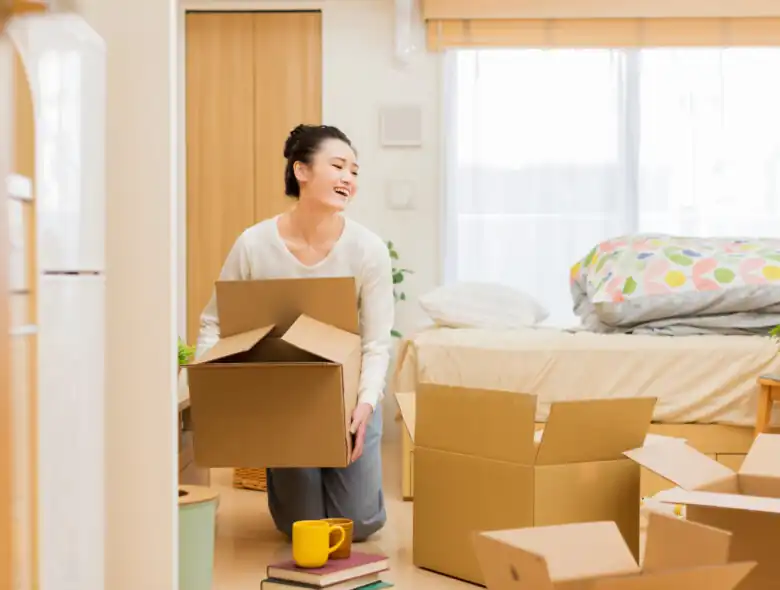Many people want to save as much as possible on moving expenses and wonder if they can move on their own. However, to move on your own, you need to source materials and drive a car to carry your own belongings.
In this article, we will introduce the advantages and disadvantages of moving on your own, as well as tips and tricks for packing and a handy checklist. If you are thinking of moving on your own, please use this as a reference.
At Village House, there are no security deposits, key money, renewal fees, or handling fees (※). If you want to save on moving expenses, please check out our website. ※Depending on the contract details and the results of the screening process, a security deposit may be required.
Advantages of moving on your own

Save on moving costs
One of the benefits of moving on your own is that you can significantly reduce expenses. Hiring professional home movers can cost anywhere from tens of thousands to hundreds of thousands of yen, depending on the volume of your belongings and the services you choose. In contrast, moving by yourself allows you to keep these expenses to a minimum.
When moving, in addition to the initial costs such as the security deposit, key money, and contract handling fees for the new house, various expenses such as purchasing new furniture and interior goods will overlap. Therefore, by handling the move yourself, you can allocate more of your budget to other necessary expenses.
Flexibility to match your own schedule
When you hire a moving company, you have to coordinate packing and moving timeline with the company’s schedule. This includes coordinating a visit for an in-home estimate, which requires aligning your availability with the company’s and inviting them to your home. On the other hand, the advantage of moving on your own is that you can decide the date yourself and proceed at your own pace.
Additionally, during peak moving seasons, moving companies’ schedules can fill up very quickly, making it difficult to secure your preferred date. For those with busy schedules or a need to complete the move on a specific day, handling the move yourself is highly recommended.
Disadvantages of moving on your own

More hassle
Moving on your own can be time-consuming and requires extra steps. First, you’ll need a vehicle to transport your belongings. If you don’t have your own car, you’ll need to arrange a rental truck, such as a light truck, which requires contacting the rental company, making a reservation, and planning for pickup and return on the day of the move.
Additionally, you’ll need to source your own packing materials. While moving companies may provide cardboard boxes for you, if you move by yourself, you’ll need to either get unused cardboard boxes from local supermarkets or purchase them from a home improvement store or online. Keep in mind that free boxes might not always be the right size or could be dirty, so purchasing these boxes in bulk might be a better option.
It takes time and effort
To move on your own, you’ll need to handle everything yourself, including loading and unloading your belongings, transporting them, and setting up furniture and appliances. Additionally, if your new home is on the second floor or higher, you will have to go up and down the stairs multiple times. For those who can’t secure enough time for the move or find it physically challenging to carry heavy items, moving by yourself can be a significant burden.
Assistance required for the move
Large furniture and appliances such as refrigerators, washing machines, beds, dressers, and sofas are difficult to transport by yourself. Therefore, you will need someone to help with the move. If you can’t arrange for help, you may have to dispose of these items at your old home and buy new ones for your new place.
Alternatively, you could hire a delivery company to transport only the larger items and carry the smaller items yourself. However, it might be cheaper to just hire a moving company to transport everything altogether. Compare the cost of having large items delivered separately versus hiring a full-service moving company to determine which option is more economical.
Three checklists to prepare when moving on your own

- Secure a vehicle for transporting items
Large furniture and home appliances cannot be transported using a personal car. Therefore, you will need a vehicle that can transport them, such as a light truck.
If you can’t borrow a car from friends or family, renting a vehicle is a recommended option. The cost of renting a vehicle varies depending on the size of the vehicle and the duration of use, so be sure to contact a rental company for details.
- Prepare cardboard boxes and packing tape
For a move, you’ll need around 10 to 15 boxes for a person living alone, or 30 to 80 boxes for a family. It’s recommended to order cardboard boxes that fit your belongings from a home improvement store or online. Additionally, make sure to prepare cushioning materials like newspaper or bubble wrap for fragile items, as well as packing tape for sealing the boxes.
- Get someone to help you on moving day
Moving is difficult to do by yourself, so be sure to ask friends or family in advance to help you. Since moving is physically demanding, don’t forget to thank those who help you. It’s important to express your gratitude in tangible ways, such as by giving a tip or treating them to a meal.
Tips for packing when moving on your own

Don’t cram your belongings into the cardboard boxes
When preparing for a move, you’ll need to pack your belongings yourself. While it might be tempting to pack as much as possible into each box to reduce the number of boxes, overpacking can make transportation difficult. If a box becomes too heavy, you should be careful because you may hurt your back when carrying it.
Additionally, overloading a box with too many heavy items can cause the bottom to fall out. To prevent this, it’s recommended to reinforce the bottom of the cardboard box with packing tape in a cross pattern to increase its strength.
Pack heavy items at the bottom and light items on top
If you place heavy items on top, there’s a higher chance of crushing the boxes below. Therefore, make sure to place heavy items at the bottom and lighter items on top. Also, be mindful of how the boxes are stacked in order to prevent them from collapsing. Ensure that the weight is distributed evenly when packing your belongings.
Pack items according to the unloading process
If you bring the larger items into the room first, the rest of the moving process will go more smoothly. For example, if you set up the storage shelves first, you can store items easily afterward. Similarly, if you bring in large furniture and appliances at the beginning, it will help you progress more efficiently with the rest of the move. Therefore, it’s recommended to load small items in first and leave the larger items for the end, as this will help ensure a smoother moving experience.
Use packing methods appropriate for each type of item
When packing, it’s important to use the appropriate method for each item. For example, fragile items like glass or ceramics should be wrapped carefully with cushioning materials or newspaper to prevent damage during transport.
Proper packing also helps reduce the effort required for both packing and unpacking. For instance, clothes on hangers can be placed directly into a wardrobe box, so you won’t need to fold them again and can move them to your new home as is. Additionally, storage cases can be transported without transferring the contents to another box, but ensure the drawers are shut and secured with tape in order to prevent them from opening during the move.
For more information on packing for a move, please check out the following article:
・Stress-Free Moving: Essential Tips for Packing Like a Pro
Cases when it is better to hire a moving company

Having many large furniture and appliances
Large furniture and appliances are often heavy and not designed to be carried. Transporting them, especially on stairs where visibility is limited, can be dangerous and may strain your back and legs. If you have a lot of large furniture and appliances, it is recommended to hire professional home movers.
Nobody to help with the move
Transporting items like refrigerators or bedding is difficult for one person to handle, and unpacking it will also be time-consuming. In that respect, having multiple people involved in the process can improve efficiency and provide support in case of accidents. If you cannot secure three or more helpers on the day of the move, it’s better to consider hiring a moving company.
Restricted by property regulations
Some properties prohibit moving on your own to prevent damage or injuries. This is particularly common in apartment complexes, where strict regulations often apply, such as requiring prior permission to use the elevator. Before moving, make sure to check in advance that moving on your own is permitted at your new residence.
At Village House, we offer properties all across Japan with reasonable prices starting from around ¥20,000. If you’re looking for a property, please feel free to contact us.
Related articles:
- 5 Tips for Moving by Yourself
- Living Alone for the First Time? Checklist of All the Things You Need
- Living Alone for the First Time: 5-Step Guide to the Process from Searching for a Room to Moving in
- How Can Women Living Alone Stay Safe? Introducing Tips for Choosing a Property and Security Measures!
- Help! Which Moving Company Should I Choose?

Hello, I’m Machiko Doi, a freelance writer who writes about housing and living in Japan.
I live in an 80-year-old house that I inherited from my grandparents along with my two shelter cats and daughter.
We live a relaxed life while repairing the house.
I like to cook vegetables from the garden and fresh fish caught by my father, and enjoy them with cold beer on a hot day or hot sake on a cold day.



